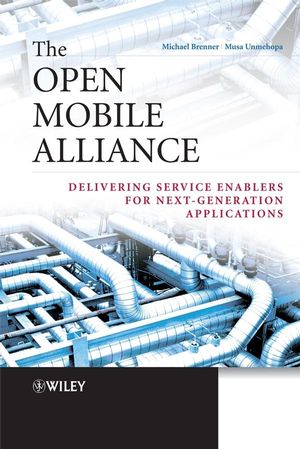The Open Mobile Alliance: Delivering Service Enablers for Next-Generation ApplicationsISBN: 978-0-470-51918-9
Hardcover
530 pages
March 2008
 |
||||||
1.0 Introduction
1.1 Service Enablers
1.2 The Open Mobile Alliance (OMA)
1.3 Service Enablers in OMA
2.0 The Silo Syndrome and its Solution
2.1 Vertical Integration
2.2 Re-use as first class citizen
2.3 The OMA Service Environment
2.4 Additional Features of the OSE
2.5 OSE and Related Technologies
2.6 Summary
3.0 The Open Mobile Alliance – An Organizational Overview
3.1 Overview of OMA
3.2 Principles of the OMA
3.3 OMA’s Relationship with External Organizations
3.4 OMA Organizational Structure
3.5 The Processes
3.6 Interoperability in the Open Mobile Alliance
3.7 Summary
4.0 Interoperability TestFests
4.1 The objective of interoperability in the OMA
4.2 The organization of the test campaigns
4.3 Planning
4.4 Finances
4.5 TestFest Statistics
4.6 Comparison with other SDOs
4.7 Summary
5.0 Service Provider - The Network Operator Perspective
5.1 The Need for OMA
5.2 Operators in OMA
5.3 OMA Challenges for the Future
5.4 Summary
6.0 Service Provider - The Enterprise Perspective
6.1 Enterprise Needs
6.2 OMA Enterprise awareness
6.3 Summary
Part II – Horizontal Topics
7.0 The Policy Enforcer Details: Model, Architecture, Realization and Impact
7.1 Policy Enforcement modeling in the OSE
7.2 Beyond the OSE: Policy Enforcement as Service Oriented Architecture Composition
7.3 Logical architecture versus deployment considerations
7.4 Relationship to Parlay and IP Multimedia Subsystem (IMS)
7.5 Policy modeling
7.6 Policy Enforcer through OMA enabler realization
7.7 Relationship of Policy Enforcer to IETF PEP/PDP
7.8 Policy assembly, composition and orchestration
7.9 Summary - Next steps
8.0 The Policy Evaluation, Enforcement and Management Enabler
8.1 Are Those specifications Really Needed?
8.2 PEEM Market Needs
8.3 PEEM Architecture and Technical Specifications
8.4 PEEM Salient Points
8.5 Impact of Specifications on the Industry
8.6 Specifications Evolution and Future Direction
8.7 Summary
9.0 Utilization of IMS in OMA
9.1 Are those specifications really needed?
9.2 Standard pre-cursors to IMSinOMA
9.3 Architecture overview
9.4. Salient Points and Divergent Views
9.5 Impact of specifications
9.6 Specifications evolution and future direction
9.7 Summary
10.0 Service Architectures - Parlay and the OSE
10.1 A Quick Taster of Parlay
10.2 The Parlay in OSE Enabler
10.3 PIOSE Challenges
10.4 Impact of Specifications on the Industry
10.5 Specifications Evolution and Future Direction
10.6 Summary
11.0 A Web Services Technology Realization of the OSE
11.1 Web Services Crash Course
11.2 A Web Services Infrastructure Framework
11.3 Mobile Web Services
11.4 The OMA Web Services Enabler Release
11.5 The Technologies Specified by OWSER
11.6 Network Identity
11.7 OWSER and the OSE
11.8 Divergent views and their resolution
11.9 Specifications evolution and future direction
11.10 Impact of the Specifications
11.11 Summary
12.0 The OMA Service Provider Environment enabler
12.1 Are Those Specifications Really Needed?
12.2 OSPE Use Cases
12.3 OSPE Requirements
12.4 Standards Pre-Cursors to OSPE
12.5 OSPE Architecture and Technical Specifications
12.6 OSPE Salient Points
12.7 Impact of Specifications on the Industry
12.8 Specifications Evolution and Future Direction
12.9 Summary
13.0 The Security Enablers
13.1 Are Those Specifications Really Needed?
13.2 Security Common Functions Enabler
13.3 SEC-CF Salient Points
13.4 Impact of Specifications on the Industry
13.5 Specifications Evolution and Future Direction
13.6 Summary
Part III – Selected OMA Service Enablers
14.0 The Presence and Group Management Enablers
14.1 Presence – What is it?
14.2 A Constructionist View of Presence Architectures
14.3 The OMA Presence Model and Specifications
14.4 A Deployment Example – Deploying Presence and XDM Enablers in an IMS or MMD environment
14.5 Impact of Specifications on the Industry
14.6 Specifications Evolution and Future Direction
14.7 Summary
15.0 The Push to talk over Cellular enabler
15.1 Are those Specifications Really Needed?
15.2 Standard Pre-cursors to OMA Push to Talk over Cellular
15.3 Architecture and Technical Specifications Overview
15.4 Salient points
15.5 Impact of Specifications on the Industry
15.6 Specifications Evolution and Future Direction
15.7 Summary
16.0 Mobile E-mail
16.1 Background
16.3 Summary
17.0 The Charging Enabler
17.1 Are Those Specifications Really Needed?
17.2 Standards Pre-Cursors to Charging
17.3 Charging Requirements
17.4 Charging Architecture and Technical specifications
17.5 Divergent Views and Their Resolution
17.6 Impact of Specifications on the Industry
17.7 Specifications Evolution and Future Direction
17.8 Summary
18.0 The Device Management Enablers
18.1 Device Management Requirements
18.2 Device Management Architecture
18.3 Device Management Enabler Specifications
18.4 Impact of DM Specifications on the Industry
18.5 Specifications Evolution and Future Direction
18.6 Summary
19.0 The Digital Rights Management Enabler
19.1 What were the drivers for those specifications?
19.2 Are those specifications really necessary?
19.3 OMA DRM Requirements
19.4 Architecture and technical specifications overview
19.5 Salient points
19.6 Impact of specifications on the industry
19.7 Specifications evolution and future direction
19.8 Summary
20.0 The Broadcast Enabler
20.1 Are those Specifications Really Needed?
20.2 Standards Pre-Cursors to BCAST Enabler
20.3 BCAST Architecture
20.4 Specifications Evolution and Future Direction
20.5 Summary
21.0 The Dynamic Content Delivery Enabler
21.1 Why Do We Need New Specifications for DCD?
22.0 The Global Permissions Management Enabler
22.1 Are Those Specifications Really Needed?
22.2 Standards Pre-Cursors to GPM
22.3 GPM Architecture and Technical Specifications
22.4 GPM Salient Points
22.5 Impact of Specifications on the Industry
22.6 Specifications Evolution and Future Direction
22.7 Summary
23.0 The Categorization based Content Screening Global Enabler
23.1 Are Those Specifications Really Needed?
23.2 Standards Pre-Cursors to CBCS
23.3 CBCS Architecture and Technical Specifications
23.4 Impact of Specifications on the Industry
23.5 Specifications Evolution and Future Direction
23.6 Summary
24.0 The Game Services Enabler
25.0 The Location Enabler
25.1 What is Location?
25.2 Location Architectures
25.3 The Mobile Location Services Enabler
25.4 The Secure User Plane Location
26.0 The Mobile Application Environment
26.1 The Mobile Web Architecture
26.2 Mobile Browser
26.3 Mobile Content Data Formats
26.4 Multiple Interaction Modalities and Devices
26.5 Summary
27 Recent Topics
27.1 The General Service Subscription Management Enabler
27.2 Device Profile Evolution
27.3 Converged IP Messaging Enabler
27.4 Mobile Advertising
Part IV – Wrap Up
28.0 Concluding Remarks, and what’s in store next?
28.1 Project Post-mortem
28.2 What’s Next?
Annex A
Abbreviations and Acronyms
References



